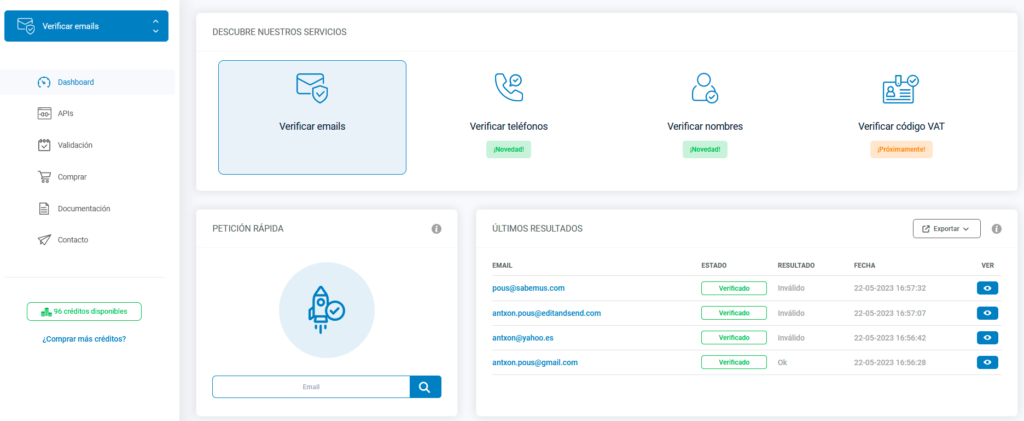Identifying whether an email is fake is crucial both to ensure personal security and to optimize email marketing campaigns. Next, we’ll explore how to discern whether an email is legitimate or not, and how these threats can affect your email marketing efforts.
Make sure you know how to tell if an email is fake:
The first step to protecting yourself and safeguarding the integrity of your email marketing campaigns is to learn how to detect fake emails. Careful examination of the sender’s e-mail address is essential. Fake emails often mimic legitimate companies, but with slight variations. This skill is crucial to maintain your subscribers’ trust in your brand.
Pay attention to wording and grammar:
Spelling and grammatical errors are obvious signs of a fake e-mail. In the context of email marketing, professionalism is essential to gain the trust of your subscribers. Poorly written or inconsistent emails can damage the perception of your brand.
Avoid getting caught in spam filters:
Fake emails often employ deceptive tactics that can lead to your legitimate emails being labeled as spam. This hurts the delivery rates and, consequently, the effectiveness of your email marketing campaigns. Keeping your subscriber lists up to date and complying with privacy regulations is essential to avoid association with fraudulent activities.
Protect your brand reputation:
Receiving fake emails that appear to come from your company can damage trust in your brand. To safeguard your business reputation, educate your subscribers on how to identify legitimate and fake emails, and how to distinguish your communications from fraudulent imitations.
Monitors participation metrics:
A sudden increase in click-through or open rates of your emails may be an indication that your subscribers are being directed to bogus emails. This could generate a distortion in your engagement metrics, making it difficult to accurately assess the real performance of your campaigns.
This is what the theory says, but in practice it is not so easy to control these points. It often requires manual work, which in the case of large email lists is impossible to do. This is where the use of professional verification tools makes sense.
A professional email validation service performs a series of exhaustive checks to determine whether an email is fake or legitimate, all automatically. These checks focus on several key aspects to help individuals and organizations discern whether an email is a phishing threat or other type of spoofed email. Some of the main checks performed by this type of service are explained here:
Verification of the sender’s e-mail address:
– The service verifies the authenticity of the sender’s e-mail address, looking for possible irregularities or discrepancies. This includes verifying whether the e-mail address uses the correct domain of the company or entity that is supposed to send the e-mail.
Analysis of SPF, DKIM and DMARC authentication:
– Email validation services check the authentication of SPF (Sender Policy Framework), DKIM (DomainKeys Identified Mail) and DMARC (Domain-based Message Authentication, Reporting, and Conformance) records to determine if the email complies with the security policies set by the sender. This helps to detect if the email has been forged.
Evaluation of the sender’s reputation:
– These services query sender reputation databases to determine whether the sender has a history of sending legitimate emails or has been involved in spam or phishing activities in the past.
Content and link analysis:
– The validation services scan the email content and examine the included links for suspicious elements such as forged URLs or links to malicious websites. They can also evaluate the presence of potentially dangerous attachments.
Verification of digital signatures:
– Some services check whether the e-mail contains a valid digital signature, which may indicate that the message is from a legitimate source and has not been altered in transit.
Email metadata analysis:
– Validation services can examine email metadata such as the IP address of the sending server, routing information and other technical details to determine if the email has a genuine origin.
Comparison with databases of known threats:
– The services query databases of known threats to verify if the email matches previously identified phishing or malware patterns.
Evaluation of writing and grammar:
– Some services analyze the wording and grammar of the e-mail for errors or indications that the message is false. This may include the detection of misspellings or unusual grammatical constructions.
In short, a professional email validation service employs a variety of techniques and checks to determine whether an email is fake or legitimate. These measures help protect users and organizations against phishing threats, fraud and other malicious emails, ensuring secure and reliable communication. Improve the deliverability of your email marketing campaigns and avoid being blocked for sending to invalid addresses.
For those of you who need to know if an email is fake, we have developed a set of tools that allow you to verify in real time the veracity of an email. To find out how the service works in detail, we recommend that you visit“How to Verify Emails“. Here is a video where you can see the features of the service.
You can test the email verification service by registering with a through the button you will find on the top right“test the email verification service“.



